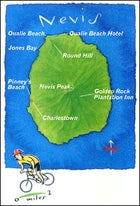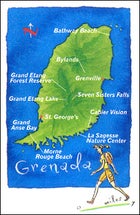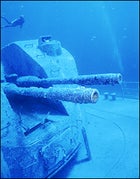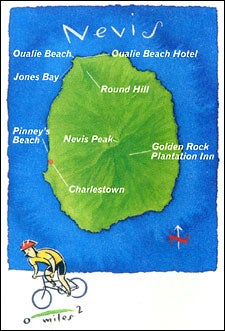Nevis: Uncrowded, Unhurried, Unsung


You have to force the action a bit on Nevis. Oh, there’s everything to do—kayak, snorkel, dive, windsurf—that you’d expect on a lush volcanic knoll in the Caribbean Leewards, but there’s no compulsion to do any of it. Why? With legends of sea beasts and fierce storms lingering in their collective unconscious, most Nevisians are happy to remain onshore. Which is why I felt perfectly authentic the day I toweled off from a morning’s snorkel and spent a few hours in the tiny capital city of Charlestown eating fresh mangoes and watching the St. Kitts ferry come in, the disembarking passengers oblivious to the two large cows strolling through Memorial Square. You can, of course, thwart the prevailing don’t-work-up-a-sweat landlubber mentality at any time and delve into the island’s sugar-sand beaches, secret dive sites, far-out windsurfing, and goat-munched singletrack. And rest assured: Your hammock will still be empty at day’s end.
The Sporting Life
Thirty-six-square-mile Nevis is content to doze beneath the tourist radar. Nevis Peak (3,232 feet) crowns the island—an ascent is a wet grunt, but worth the effort. Go with Linnell Liburd (Sunrise Tours, 869-469-2758) to avoid confusion amid a warren of routes. Nevis’s heritage as a British colony of sugarcane plantations accounts for the grand-manors-turned-hostelries, as well as the network of abandoned roads made to order for fat-tire wanderers. “If you see a trail, follow it,” is Winston Crooke’s advice at Mountain Bike Nevis (869-469-9682). Winston also runs Windsurfing Nevis; sideshore winds at Oualie Beach make it an ideal novice’s venue, but paddle beyond the placid bay and a funnel effect in the two-mile-wide channel between Nevis and St. Kitts creates bump-and-jump stuff not for the faint of heart. Ellis Chaderton runs Scuba Safaris (869-469-9518; www.divenevis.com), the island’s only dive operation. He’s charted 40 different sites, including a favorite called Booby High Shoals, where flotillas of nurse sharks and monstrous lobsters hang out. Two-tank dives cost $80.
The Beach
Oualie Beach, 250 yards of searing white sand, couldn’t be better protected, with headlands at both ends, thousand-foot Round Hill just behind, and the mountainous east end of St. Kitts just across a channel. The water is 81 degrees and virtually all of the island’s water-sports centers are here. For all that, Oualie is perennially serene.
After the Sun Goes Down
Make for Sunshine’s, a sandy shack of dubious but unquestioned legality on Pinney’s Beach that thumps nightly with reggae, blues, and jazz. The gregarious eponymous owner grills the catch of the day along with chicken and ribs, served up with a wicked concoction he calls the Killer Bee (rum being the killer ingredient).
Lay Your Sunburned Head At…
Why choose? Do surf and turf. Golden Rock Plantation Inn lies at the base of Nevis Peak about three miles inland from the windward beaches, at the cusp of the rainforest. Trails lead right out the door into the dense jungle. The stately manor has been converted into a dining room and lounge, and seven stone cottages, scattered about the ambling grounds, have ocean views and private terraces. Be sure to reserve the limestone sugar-mill tower containing an impossibly romantic circular suite. Doubles cost $140-$365 (869-469-3346; ). For surf, head to Oualie Beach Hotel, where 34 gingerbread cottages sit right on the beach. Each has a screened tile-floor terrace with chaise longues and a glorious view of the sunset over St. Kitts. Doubles range from $105-$345 (869-469-9735; ).
Très Nevis
Listening to LaRue the Parrot squawk, “Pretty bird, what a pretty bird,” as you scarf your cornflakes on Golden Rock’s breakfast terrace; joining a group of urchins playing broomstick cricket in the street; testing the mysterious “goatwater” appetizer at Cla Cha Del on Jones Bay while Pas the bartender Osterizes a mango colada.
The Price of Paradise
Nevis needs Lady Bird Johnson. The roads are lined with trash, much of it courtesy of the goats and wild donkeys that upend flimsy trash cans.
Resources: Nevis’s New York tourism office: 800-582-6208;
Grenada: The Life of Spice


A milk cow tethered to a rusting Air Cubana prop plane, a relic from the Cold War, watches with regal boredom as we spin doughnuts on the old airstrip of Grenada’s long-defunct Pearls Airport. The runway stops at the edge of the deep blue Caribbean Sea, where I toss my last bite of lambi roti (a sort of conch burrito) to a foraging billy goat. I’m exploring Grenada with Anna Magni, an Italian expat who has offered to show me around the island for the day. We’ve just come from soaking in a hot spring up in the lush hills near the village of Bylands, having pulled ourselves away from the seductive sands along the tourist strip of Grande Anse Bay just long enough to hike the primeval mountains dominating the 21-mile-long island. At the hot spring, we met a reefer-puffing Rasta man, who thrust his cutlass at the surrounding jungle and told us, “Jes’ look aroun’ you, mon, dis is Greeen-a-da. You got to park de car, hike into de hills, and you will freak.” Taking his advice, we made our way along a one-and-a-half-mile muddy trail in 3,000-acre Grand Etang Forest Reserve through groves of fruit-heavy nutmeg trees and creaking bamboo to visit the Seven Sisters, a series of tumbling waterfalls east of Grand Etang Lake. Swimming in the rushing water, the scent of nutmeg wafting through the air, we got the Rasta man’s gist, and, well, I freaked.
The Sporting Life
The attractions aren’t all topside here—dive the wreck of the Bianca C, an enormous, 600-foot-long Italian cruise liner sunk in 165 feet of water (Ecodive, 473-444-7777; ), swim among nurse sharks, stingrays, barracuda, and moray eels off the scrubby nearby island of Carriacou (Carriacou Silver Diving Ltd., in Hillsborough, 473-443-7882; ), or watch humpback whales cruise by Grenada between December and April (First Impressions Ltd., 473-440-3678; ). Anna Magni of The Wandering Gecko Marketing and Management Ltd. can arrange any number of hiking and diving itineraries (473-444-2662; ).
The Beach
The sweeping sands of two-mile Grande Anse beach are Grenada’s version of Waikiki. Here you’ll find the majority of sun-damage-seeking visitors. Find more space and ditch your tourist stigma at Bathway Beach, on the island’s northeastern tip, an inviting half-mile, palm-lined strip—but beware of dangerous currents out past the reef.
After the Sun Goes Down
Everyone from cabinet ministers to beach vendors dances a sexy little number known as “wining” (imported from nearby Trinidad) at Fantazia 2001, a popular nightclub at Morne Rouge Beach. Brush up on “jamming”—a move as erotic as you’d care to get in public—in your bedroom mirror before attempting it on the dance floor.
Lay Your Sunburned Head At…
It’s hard to beat La Sagesse Nature Center. The small, secluded hotel is tucked away on the southeast coast above a quiet beach with great snorkeling. Stay in a restored manor house or in either of two cottages with wraparound verandas overlooking the ocean (doubles $75Ð0; 473-444-6458; ). Farther afield on the southeast coast is Cabier Vision, a hip, beautifully designed new ten-room guest house, built on a rock overlooking the ocean (doubles $70; 473-444-6013; ).
The Price of Paradise
Check your brakes and practice blowing your horn, because navigating Grenada’s narrow, winding, guardrail-free roads is not for the timid. “Hit Me Easy” and other evocative local nicknames for particularly hairy bends give you an idea of what to expect.
Très Grenada
Place bets at the Flamboyant Hotel’s Monday-night hermit-crab races; haggle for nutmeg and cloves at the Saturday-morning market in St. GeorgeÕs; avoid partying anatomy students from the island’s infamous and very social medical school.
Resources: Grenada Tourist Board, 800-927-9554;
St. John: The Island of Eco-Delights


It’s no surprise that Laurance Rockefeller snapped up most of St. John for his private fiefdom in the 1950s, given the island’s rolling green hills, pristine bays, and Pepsodent-smile-white beaches. What’s surprising—and a boon for the average sun-worshiping schmo like you and me—is that in 1956 he gave 5,000 acres to the National Park Service, which now oversees 7,200 acres of land (about half of the 19-square-mile island) and 5,360 acres of surrounding water. Today, Stanley Selengut, the ecotourism guru who’s developed an enclave of green resorts (Maho Bay, Concordia, Harmony), has replaced Rockefeller as the island’s keeper. Even if you don’t stay in one of his elevated platform tents outfitted with shared bathhouses and recycled everything, you’ll find yourself communing with nature most of the time anyway—hiking, sea kayaking, diving, sailing, and swimming. Although the island is only a short ferry ride from St. Thomas, a cruise-ship mecca the Johnnies would probably love to torpedo, St. John has managed to escape the duty-free-shop/souvenir-stand fate of its buck-churning neighbor.
The Sporting Life
Start high in the hills on one of Virgin Islands National Park’s 22 hiking trails and work your way down to the waves. The scenic Reef Bay Trail (2.2 miles, two hours) descends 957 feet from Centerline Road to the Reef Bay Valley and ends at Genti Bay beach. Reserve a spot on a ranger-guided hike and pay $15 for the boat ride to Cruz Bay; call the Park Service Visitors Center in Cruz Bay (340-776-6201). Arthur Jones will take you sea kayaking to nearby Henley and Lovango Cayes ($75, full day) with his outfit Arawak Expeditions (800-238-8687; ), or to points beyond (some in the British Virgin Islands) on one of his kayaking and camping tours (five days, $995; seven days, $1,195). He also runs a new adventure week with Maho Bay Camps ($1,295 in winter, $1,125 in summer). Sandy West runs six-hour snorkeling trips to Hurricane Hole and other hard-to-reach spots on her 40-foot Lindsey Trawler, the Sadie Sea ($65; 340-776-6421; ). Scuba divers can explore the abundant local waters on both day and night dives with Low Key Watersports, which also offers a three-day PADI certification program ($350; 800-835-7718; ).
The Beach
The snow-white sand of three-quarter-mile-long Trunk Bay, on the island’s northwestern shore, is the most photographed beach on St. John, but it tends to get crowded, thanks to an express shuttle from the ferry dock. Head instead to the north shore, where you’ll find a handful of gorgeous beaches, all part of Virgin Islands National Park. The liveliest is Francis Bay—a great place to spot sea turtles in the shallows, and pelicans, ospreys, yellow-bellied sapsuckers, and banana quits camouflaged by the nearby marsh’s mangroves.
After the Sun Goes Down
Sure, you came here for the peace and quiet, but let’s face it, debating the pros and cons of low-flow showerheads at an eco-resort workshop isn’t nearly as much fun as getting ripped with the local hippies at Skinny Legs—an open-air bar in Coral Bay.
Lay Your Sunburned Head At…
Harmony Studios shares the same stunning location as legendary Maho Bay Camps (Selengut’s original tent-cottage resort). Plus, it has real walls (as opposed to fabric) and you don’t have to share bathrooms. Harmony’s six miniature townhouses, most of which have incredible views of Maho Bay, are solar powered and were built almost entirely of recycled materials (tiles made from crushed lightbulbs, countertops from recycled glass—the works). Each unit has a balcony and a full kitchen (doubles, $110-$210 per night; 340-776-6240; ). For total privacy nothing beats renting a villa. Try Park Isle Villas (340-693-8261; ), on lush Battery Hill overlooking Cruz Bay.
Très St. John
Getting busted by a park ranger for nude sunbathing at Salomon Bay (St. John’s unofficial nude beach); watching baby sea horses frolic among the mangroves at Hurricane Hole; feeling like a crunchy Über-conservationist after checking into your Maho Bay digs.
The Price of Paradise
Thanks to its blue-blood past, St. John has been de-Caribbeanized—if you want cultural attractions and lively local flavor, go elsewhere.
Resources: U.S. Virgin Islands Tourist Information Board, 800-372-8784;
Tobago: The Tranquility Zone


Hey! Let’s stay up all night and parade through the streets nearly naked to the sound of steel-drum music! Oh, sorry, that’s Trinidad. Tobago, the altogether more serene, and green, sibling of the two-island nation of Trinidad and Tobago, has been environmentally conscientious for so long that it established a forest preserve—the oldest in the Western Hemisphere—ten years before America signed the Declaration of Independence. Peace and quiet is so much the draw on this 21-by-seven-mile island, some two-thirds of it still covered by mountainous rainforest, that it has long served as a morning-after decompression chamber for survivors of Trinidad’s annual pre-Lenten carnival. But Tobago’s unique charms draw their own devotees: serious birders, drift-dive scuba enthusiasts, and Robinson Crusoe-caliber escapees from society. To really fit in, though, you have to master one of the cornerstones of Tobago culture—”liming,” lying back and doing nothing at all.
The Sporting Life
Divers can swim through tunnels and drift along canyons near the north end of the island in search of sharks and elusive rays in the nutrient-rich water that’s pushed along from South America by the Guyana Current. Man Friday Diving (single-tank dive $35; 868-660-4676; ) is on the north end of the island. The best of the excellent island-wide snorkeling is among the coral gardens at Buccoo Reef, Speyside, and Mount Irvine Bay. Rent snorkeling gear at Wild Turtle Dive Safari at Pigeon Point Beach Resort ($14 per day for mask, fins, and snorkel; 868-639-7936; ). For birders, hikers, and mountain bikers, trails run like veins across the rugged spines of the 14,000-acre Tobago Main Ridge Forest Reserve. The 15-mile Gilpin Trace trail will lead you to a couple of 20-foot waterfalls in about 45 minutes. Local naturalist David Rooks offers two-and-a-half-hour hikes for $45 (868-639-4276).
The Beach
Avoid the well-lathered crowds between Pigeon and Crown Points near the biggest concentration of hotels. Instead, make your way to the pure white sand, calm water, and satisfying isolation of Englishman’s Bay, near Parlatuvier, on the north coast. If there is anyone else in sight of your beach towel, you are there on a busy day.
After the Sun Goes Down
On Sunday nights head for Sunday School, the high-decibel street dance that invariably gets cranking in the tiny village of Buccoo. The rest of the week, there is more to Tobago nightlife than listening to the tiny forest creatures. But not much.
Lay Your Sunburned Head At…
At Footprints Eco Resort, ease your environmental conscience on 62 acres of a former sugar and cocoa estate overlooking Culloden Bay. Built of local and recycled materials, its main four-room lodge sits on the ocean, while three thatch-roofed cottages, each with its own solar-heated Jacuzzi, have a bit more privacy back in the trees (doubles $95-$300; 800-814-1396; ).
Très Tobago
At Jemma’s, in Speyside, try not to fall out of your chair over the view that comes with your dinner—the restaurant is built in a massive sea-almond tree hanging over the water; make points with the locals by amping up your enthusiasm for their beloved goat and crab races.
The Price of Paradise
Adding to the damage, mostly in the form of coral broken by flippers, already done to Buccoo Reef.
Resources: Tourism and Industrial Development Company of Trinidad & Tobago (TIDCO), 868-623-6022;
Cayman Brac: Where Beauty is Skin-Diver Deep


Looking to open an offshore bank account? Book a trip to Grand Cayman. Dock-flat desolation? Little Cayman. But if you want stellar scuba diving, climbable cliffs, ridiculously friendly locals, a smattering of beachfront resorts, and enough Happy Hours to keep you steeped in a week’s worth of perma-grins, head for cigar-shaped Cayman Brac, about 165 miles northwest of Jamaica. This scruffy, hard-baked, 12-by-two-mile isle is not Bali-Hai beautiful, but it does have some pleasantly surprising topography: A cave-pocked limestone spine runs along the middle of the island, rising to 140 feet on its sheer east end; just offshore, teeming spur-and-groove reefs, coral- and sponge-flocked 3,000-foot vertical walls, and vertigo-inducing water clarity combine to produce some of the planet’s best diving.
The Sporting Life
There are 50 or so mostly current-free dive sites around the Brac, with water temperatures hovering between 75 and 85 degrees and visibility usually to 150 feet. Some sites, including the sponge-heavy Radar Reef, just 150 yards off the boat ramp at Stake Bay, can be reached from shore by strong swimmers. Other notable dives: Tarpon Reef, with deep sand gullies, thick staghorn coral, and schools of nearly unspookable giant tarpon; Rock Monster Chimney wall, with several coral-chimney swim-throughs; and an intentionally sunk 300-foot Russian frigate, home now to barracuda, angelfish, jacks, groupers, and giant jewfish. Call Reef Divers (two-tank dive, $80; 800-327-3835; ) or Dive Tiara (two-tank dive, $60Ð$90; 800-367-3484; ). Climbers can tackle some 70 bolted routes between 5.8 and 5.12 at seven different locations on the bluff; locals rebolted most routes with titanium glue-ins after stainless-steel bolts began breaking down. There are no climbing outfitters on the island; get detailed climbing-route information from local rock jock John Byrnes, owner of the Bluff View House (970-493-5801; ). Anglers will find bonefish, tarpon, and possibly permit in the flats ($80Ð $150; Munny’s Fishing Service, 345-948-1228); and marlin, tuna, and wahoo out beyond the reef ($350Ð$600; Barefoot Watersports Ltd; 345-948-1537).
The Beach
While most of the shoreline is ironstone that will shred your bare feet, there are stretches of sweet sand, especially on the island’s west end, where the Brac’s few resorts are clustered. The best swimming area is in the lagoon at the small public beach on Southeast Bay; it’s protected by a snorkelable coral reef about 50 yards offshore.
After the Sun Goes Down
Head for The Captain’s Table Bar and Restaurant at the west-end beachfront Brac Caribbean Beach Village—just past the 15-foot-high statue of Blackbeard the Pirate—where visitors, divemasters, and expats load up on Coronas and conch fritters.
Lay Your Sunburned Head At…
The Brac Reef Beach Resort (three-night packages with diving cost $528Ð$686 per person; 800-327-3835; ), on the island’s westernmost point, has a pool, a sandy beach, 40 air-conditioned rooms, and the ubiquitous yet essential tiki bar; the excellent Reef Divers operation is based here. Climbers head for the two-unit east-end Bluff View House (doubles from $80 per night, with full kitchens; 970-493-5801), within easy walking distance of some of the island’s best climbing routes.
Très Cayman Brac
Dive as deeply and as frequently as your divemaster and decompression charts will allow. Take an afternoon jeep ride to the east end and be waved at by every human you encounter. The night before you head home, power down several frozen mudslide cocktails at The Captain’s Table, ask the bartender for paint, decorate a piece of driftwood with witty farewell rhymes, and hammer your sign onto the already jammed post by the pool.
The Price of Paradise
Construction of homes for wealthy foreigners has jacked land prices out of reach for most—1.75 acres of prime beachfront can cost as much as $925,000—and has created potential for reef-wrecking runoff, and an overabundance of know-it-all divers with expensive gadgets.
Resources: Cayman Islands Tourist Board (800-346-3313; ). Cayman Brac info:



